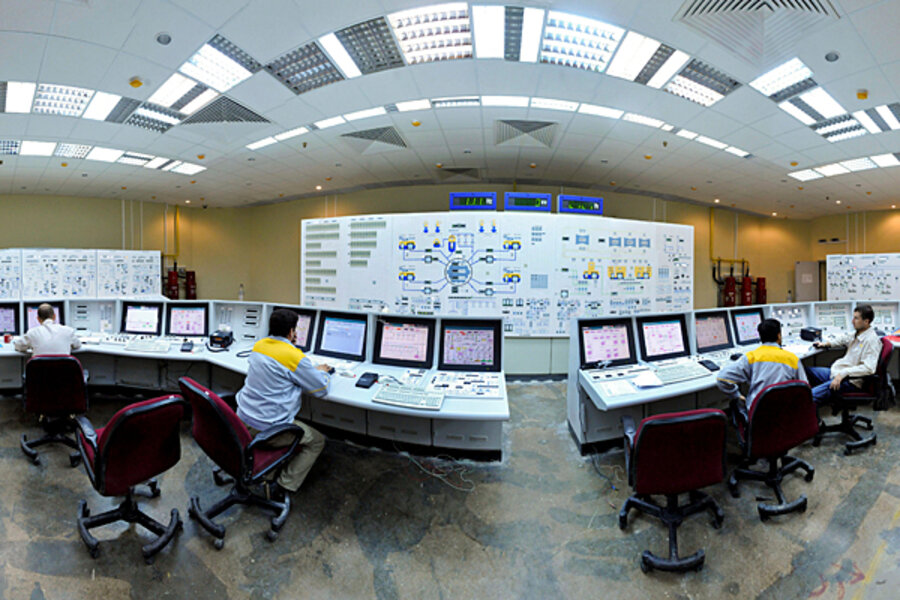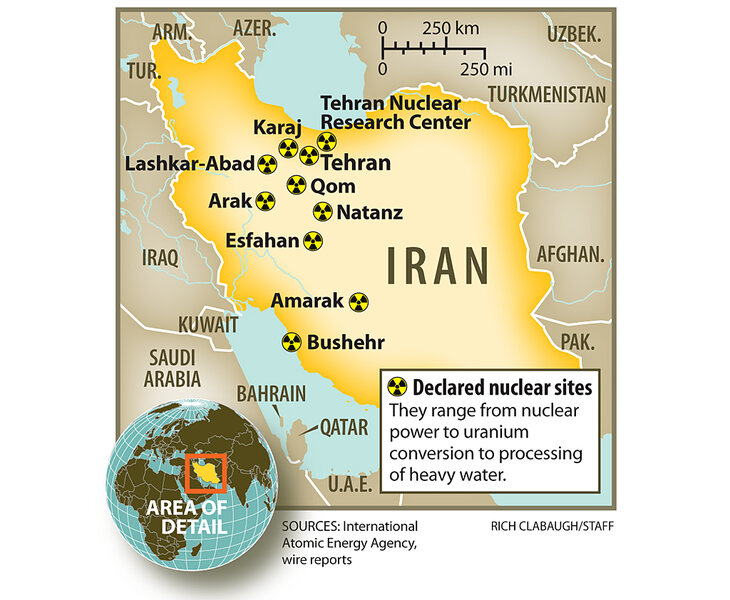IAEA report: What's driving Iran's latest bout of nuclear obstinacy
Loading...
| Istanbul, Turkey
Iran reacted angrily Tuesday to charges from the United Nations nuclear watchdog that it was hindering an investigation of its nuclear programs by blocking experienced inspectors and limiting access and design information.
In its quarterly report on Iran, the International Atomic Energy Agency (IAEA) stated Monday that Iran has “not provided the necessary cooperation to permit the Agency to confirm that all nuclear material in Iran is in peaceful activities.”
The report provides the latest indication of a spreading pattern of restrictions under President Mahmoud Ahmadinejad to limit the work of nuclear inspectors, according to Iran experts. They say hurdles facing inspectors are raised as American and Western pressure on Iran increases over its nuclear program. The UN Security Council (UNSC) imposed a fourth round of sanctions last June.
“What we are seeing is an accelerating loss of transparency into Iran’s nuclear fuel-cycle program,” says Shannon Kile, a nuclear specialist at the Stockholm International Peace Research Institute (SIPRI) in Sweden. “I’m not surprised … that the Iranians are becoming even less cooperative than before. Everyone expected after the last [UN vote] that the Iranians would find some way to retaliate.”
The IAEA said it had “full confidence in the professionalism and impartiality” of two inspectors, who Iran recently said would not be allowed to do further work in the country. In an official letter to the IAEA last June, Iran accused the two – whose nationalities were not disclosed – of “false and wrong” reporting of undeclared nuclear experiments.
“We have the right to replace inspectors regarding their background and activities,” Iran’s Foreign Ministry spokesman, Ramin Mehmanparast, said Tuesday, echoing senior nuclear officials who accused the banned inspectors of filing reports “contrary to reality.”
“We insist that the IAEA accomplish its legal activities regarding member states by disregarding political pressure," said Mr. Mehmanparast.
Who's right?
The IAEA report acknowledged that Iran has the right to bar any inspector, but that it “rejects the basis” of the recent ban. The report noted “repeated objection to the designation of experienced inspectors hampers the inspection process.” It further asked Iran to reconsider its January 2007 decision to block 38 inspectors, and four others before that.
“This is typical Iranian hardball tactics, saying ‘Two sides can play tough, what are you going to do about it?’ ” says Shahram Chubin, a Geneva-based Iran expert with the Carnegie Endowment for International Peace. “I hesitate to say they are reading the letter of the [safeguards] agreement – they are even reading less [and] are certainly not holding to the spirit, which is to have inspectors reassure the agency of what you are doing.”
Iranian officials have warned in recent years that increased scrutiny by the UNSC of its nuclear program, which Tehran says is only to peacefully produce nuclear power, would cause it to reel in cooperation to the minimum required by the Nuclear Non-Proliferation Treaty (NPT).
The latest IAEA report reflects that modus operandi. It includes multiple references to IAEA requests for information – or design details – that are met with stiff official replies saying that Iran had already complied with its obligations, or that details would arrive “in due time,” or that there was “no legal bases” for certain IAEA requests.
The report notes that in the space of the past eight months, Iran has increased its stockpile of homemade low-enriched uranium (LEU, at a level less than 5 percent) by more than half, to 2,800 kilograms (roughly 6,160 pounds).
Likewise, since February, Iran has created 22 kg (48.4 lbs) of uranium enriched to 20 percent – still some distance from the levels above 90 percent needed for a bomb, but technically not too far off the capability to do so.
Moving fast
“The regime is moving on as fast as it can – neither faster nor slower than usual – just as fast as it can. And eventually it will get there,” says Mr. Chubin, author of the 2006 book “Iran’s Nuclear Ambitions.”
“They think they are not going to get a clean bill of health, whatever they do – that’s really the bottom line,” says Chubin.
Chubin says that since Iran views the nuclear inspections as a precursor to regime change, the government has no motivation for complying with demands to stop its work.
The IAEA took issue with Iran’s narrow interpretation of its obligations and noted flatly that Iran had “failed” to comply with resolutions of the UNSC and IAEA Board of Governors that require Iran halt all uranium enrichment until remaining questions of possible weaponization efforts are resolved.
It was “essential that Iran engage with the Agency on these issues … without further delay,” the IAEA stated.
Iranian officials have dismissed previous votes by the UN and the IAEA against it as worthless “scraps of paper,” and say they have not violated the NPT. The IAEA report makes no mention of a fuel-swap deal Iran made under the auspices of Turkey and Brazil last May, which would have seen 1,200 kg (2,640 lbs) of Iran’s homemade LEU shipped out of the country to be made into specialty fuel.
Billed by its signatories as a confidence-building measure, the deal was panned by the US and other Western powers for not going far enough. Mehmanparast, the Iranian spokesman, said Tuesday that Tehran was awaiting word from the so-called Vienna Group – the US, Russia, France, and the IAEA – to “declare its readiness to talk.”
“The fear is that the Iranians are going down a path that has been trodden before, [in which] the outcomes have not been happy ones,” says Mr. Kile at SIPRI. North Korea, which now has a handful of nuclear warheads, “basically stonewalled the IAEA for 5 ½ years … from the time they signed the NPT.”
Warning flags abound about Iran’s deteriorating relations with the IAEA, says Kile, and include public declarations by politicians – but no official explanation to the IAEA – about large expansions of Iran’s nuclear program and capabilities.
Improved relations with the IAEA are not likely to come from within Iran. Ever since the archconservative government of Mr. Ahmadinejad took power in 2005 – claiming that his reformist predecessors were weak – Iran's nuclear program has grown from one with a few hundred centrifuges to 3,772 spinning, out of the 8,856 installed.
Iran has made few indications that it will slow down, and none that it will stop enriching uranium. So more creative diplomacy, suggests Chubin, may be required to shift the dynamic.
“I don’t think the West has asked: ‘What will we give them?’ I know it sounds like rewarding proliferation and so on, but what can we live with?” in terms of Iranian capabilities, asks Chubin. “[Iran] will get there, unless the West comes up with a package [and decides] what they would accept as a bottom line.”



